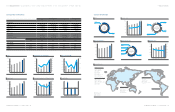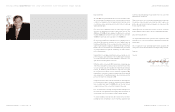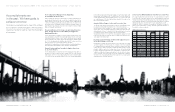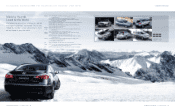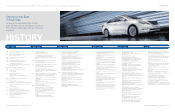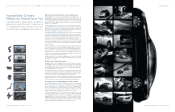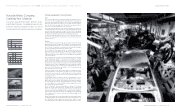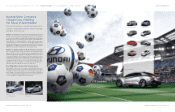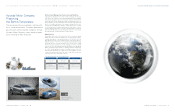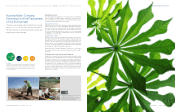Hyundai 2009 Annual Report Download - page 17
Download and view the complete annual report
Please find page 17 of the 2009 Hyundai annual report below. You can navigate through the pages in the report by either clicking on the pages listed below, or by using the keyword search tool below to find specific information within the annual report.
A World-Leading Global Production Network
Korea
Ulsan I As Hyundai Motor’s main production facility, the Ulsan Plant sits on a
5,050,000 m
2
site and is equipped with five independent plants that employ over
34,000 personnel to produce an average of 5,400 vehicles a day. Additionally, the
plant has its own port where up to three, 50,000-ton ships can anchor simultane-
ously. The Ulsan Plant, also dubbed the “Forest Plant,” encompasses 580,000
trees as part of its landscape and state-of-the-art facilities.
Asan I With an annual capacity of 30,000 units, the Asan Plant is an entirely self-
contained, independent automobile production complex that mainly produces
stra-
tegic mid -to large-size passenger cars for export. The Asan Plant offers a bright and
pleasant, people-oriented and nature-inspired working space, and has proven
that
the quality of the working environment determines the quality of products.
Jeonju I With an annual production capacity of 125,000 units, the Jeonju Plant
specializes in producing mid-to large-size buses, trucks, and specialty vehicles
that exceed 2.5 tons.
Overseas
America I Within one year after it began mass production in May 2005, the Ala-
bama Plant achieved the incredible feat of being placed 10th in product quality
among 37 plants in North America. It focuses on mid-to full-size vehicles, and con-
tinues to live up to its reputation as a comprehensive automobile plant that applies
the latest technologies and techniques to its production lines.
China I In addition to the existing first plant, a second plant with an annual ca-
pacity of 300,000 units was added to the China Plant, increasing its total annual
production capacity to 600,000. The plant is a reassuring foothold in securing a
sizable share in the automobile market in China, which is rapidly becoming a global
economic powerhouse.
India I A comprehensive, self-sufficient automobile plant that focuses on the R&D,
testing, manufacturing, and sales of new products that are adapted to the Indian
market, the India Plant added a second plant in 2008 to achieve an annual pro-
duction capacity of 600,000 units. It serves as an overseas manufacturing plant
for compact cars, such as the first overseas-specific model i10 and the strategic
European model i20. It has accomplished much in India’s automobile industry,
including setting a production record of 2,500,000 units and sales of 1,000,000
units in the shortest time, and is responsible for 20% of the market share and
66% of the automobile export in India.
Turkey I The expansion of the Turkey Plant in March 2007 resulted in an increase
in the annual pro
duction capacity from 60,000 units to 100,000 units. A strategic
foothold that connects Europe, Africa, and the Middle East, the Turkey Plant plays
a key role in the increase of exports from the region through the localization of the
Accent and i20 models.
Czech Republic I Nineteen months after its historic groundbreaking, the Czech
Republic Plant commenced mass production in November 2008. The Czech Re-
public Plant focuses on a strategy of full localization to develop models geared to
the tastes of European consumers. Taking full advantage of its strategic location in
the center of Europe, the Czech Republic Plant will be a stepping stone to Hyun-
dai’s expansion into the European market.
Russia I Scheduled to commence mass production in January 2011, the Russia
Plant is the only auto plant in Russia that can handle the entire manufacturing
process of complete units. The plant will start off with an annual production
of 100,000 units, which will eventually increase to 150,000 units. Comprised of
expert employees trained in Korea and in the Czech Republic, the Russia Plant will
focus on production of the C-Class models with reinforced designs adapted to the
local needs in Russia.
Brazil I The Brazil Plant will secure a manufacturing foothold in the biggest market
in Central and Latin America and play an important role in increasing sales in the re-
gion. The Brazil Plant will be producing stylish and fuel efficient compact cars suited
for the Brazilian market, and contribute to increasing the market share in the region.
2009 Annual Production of
Overseas
Plants
(Unit : ‘000 units)
2009 Annual Production of Domestic Plants
(Unit : ‘000 units)
U.S.A
Ulsan
China India
Asan
Turkey Czech
Jeonju
400
600
1,500
200
1,000
100
500
10
100
1,301
250
196
571 560
118
49
56
>>
GLOBAL PRODUCTION SYSTEM
Hyundai Motor Company,
Creating Your Lifestyle
Customers have different needs, different tastes,
and different lifestyles. Our global network of state-
of-the-art manufacturing plants makes cars that fit
the lifestyle of each and every one of our customers
.
Ulsan Plant
Alabama Plant
India Plant
HYUNDAI MOTOR COMPANY I 2009 ANNUAL REPORT I 33HYUNDAI MOTOR COMPANY I 2009 ANNUAL REPORT I 32
INTRO I FINANCIAL HIGHLIGHTS I MESSAGE FROM THE CEO I TO TRUTH I TO POWER I HYUNDAI WITH THE WORLD I TO FUTURE I HYUNDAI WITH HONESTY I SUPPLEMENT I FROM HYUNDAI


